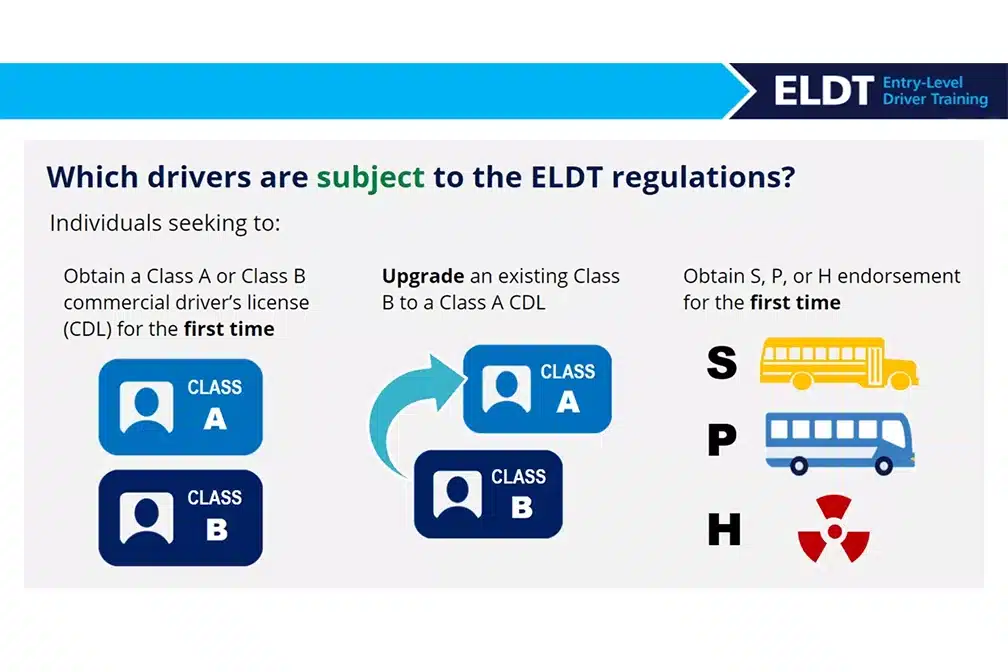Connell High School in Connell, Washington, has formally petitioned the FMCSA to allow students under 18 to obtain commercial learner's permits (CLPs).
Continue Reading
May 19, 2024 4:52 pm

The Entry Level Driver Training (ELDT) rule. This federal mandate, implemented on February 7th, 2022, was designed to establish uniform standards for training entry-level truck drivers. While the intention behind the ELDT rule is to enhance road safety and professional standards in the industry, it has stirred a debate among trucking professionals regarding its effectiveness and the challenges it poses for driver recruitment.
The ELDT rule mandates specific training requirements for both providers and those seeking a Commercial Driver’s License (CDL). It ensures that every new driver gains a comprehensive understanding and practical experience before operating a commercial vehicle. This move was expected to raise the bar for driving skills and safety awareness among new entrants in the field.
However, the rule’s implementation has been met with mixed reactions. While it undeniably aims to elevate training quality, it also introduces complexities that affect the recruitment of new drivers. Matt Wells, Vice President of the Mid-West Truckers Association, points out that despite the growing demand for drivers, the ELDT rule has led to a plateau in the number of truck drivers entering the industry. This stagnation is attributed to the increased hurdles and training time that the ELDT rule introduces, deterring potential new entrants.
One of the critical oversights of the ELDT rule is its universal application, regardless of the specific roles within the trucking sector. For example, local township supervisors who operate dump trucks are now required to undergo the same level of training as long-haul truck drivers. This broad-stroke approach neglects the distinct needs and contexts of various trucking roles, potentially leading to unnecessary training burdens for some.
Recognizing the barriers posed by the ELDT, the government and educational institutions have initiated funding programs to encourage more people to join the trucking workforce. A notable example is the $48 million in grants aimed at bolstering trucking programs in colleges. These programs, like the one at Illinois Central College, offer financial incentives to students, including an hourly wage and coverage of course fees. However, despite these efforts, the increase in student enrollment remains modest, indicating that financial incentives alone might not be enough to offset the challenges posed by the ELDT rule.
The trucking industry’s response to the ELDT rule underscores the need for a balanced approach. High training standards are crucial for ensuring safety and professionalism on the road. However, the training requirements must be adaptable to the diverse roles within the trucking ecosystem. The ongoing discussions to repeal or modify the ELDT ruling are a testament to the industry’s efforts to find a solution that fosters both growth and safety.
As these deliberations continue, it’s essential to consider the broader implications of the ELDT rule. For instance, the trucking industry is not just about long-haul transportation; it encompasses a wide range of activities, including local deliveries, construction, and municipal services. A one-size-fits-all training model might not be the most effective way to address the unique requirements of these different segments.
Moreover, the rule’s impact on the industry’s demographic is another aspect worth considering. The trucking sector has traditionally struggled with diversity, and additional training requirements could further complicate efforts to attract a more varied workforce, including younger drivers, women, and minorities.
In conclusion, while the ELDT rule represents a significant step towards standardizing and improving training for truck drivers, it also brings to light several challenges that need careful consideration. The trucking industry’s future hinges on finding a harmonious balance between maintaining high safety standards and ensuring the smooth entry of new drivers into the workforce. As the industry evolves, so must its approach to training and recruitment, adapting to the changing needs of the road and those who travel it
Connell High School in Connell, Washington, has formally petitioned the FMCSA to allow students under 18 to obtain commercial learner's permits (CLPs).
Continue ReadingThe U.S. government is increasing scrutiny on Chinese companies that are potentially dodging tariffs by manufacturing Chinese EVs (electric vehicles) in Mexico.
Continue ReadingIn a legal battle that could reshape the trucking industry, 24 Republican states join to bring a lawsuit against the EPA and the state of California.
Continue ReadingThe American Trucking Associations (ATA) has expressed strong opposition to the Department of Justice's proposed rule of marijuana reclassification.
Continue ReadingIn an effort to increase efficiency and sustainability in Trucking, Phillips Industries has launched their new, advanced, stick-on solar panels
Continue ReadingThe 2024 CVSA International Roadcheck is scheduled for May 14-16. Over 72 hours, inspectors across the US will conduct nearly
Continue ReadingAutomated License Plate Readers are a major advance in law enforcement technology but they raise significant privacy and oversight challenges.
Continue ReadingThe EPA's latest emission standards detailed in a final rule issued on March 29 are sparking vigorous debate within the
Continue ReadingOOIDA • ATA • DOT • NASTC • WOMEN IN TRUCKING • NPTC • DRIVER RESOURCES • TDN STAFF • ARCHIVES • SITEMAP